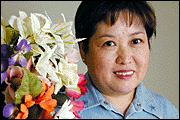Advertisement - Click to support our sponsors.


In The Garden
![]()
Friday, January 21, 2000

By Dennis Oda, Star-Bulletin
Chrysanthemums of Hawaii owner Dean Takabayashi raises the
spinach-like Dawn Dewa, also known as Mollucan spinach and
Googoolipid, in 6-inch pots for sale through stores. Each pot is
watered through a tiny irrigation spigot.
No one quite knows how the Dawn Dewa, also known as the Leaves of the Gods in Indonesia, came to Hawaii. But the word in gardens around town is that it is more than a versatile vegetable plant. The rough-textured leaves, suitable for salads, stir-frying and steaming, supposedly can lower cholesterol levels. Claims grow for
new ‘spinach’"I tend to be very skeptical of this kind of claim," said George Staples, Bishop Museum's botanist. "Unless there are scientific tests to back up the claim, we don't know what we've got."
But Gerald Tanoue, owner of Waiau Fish Market in Stadium Mall, believes it is a cure for high cholesterol. "I've given it to 500 people, and all 500 people tell me it works. So it must work," said Tanoue, who has advised his customers, friends and family to eat the raw leaves.
Staples has identified the plant as Gynura nepalensis belonging to the Compositae family, which includes plants such as chrysanthemums and daisies. But he has not found scientific data to support the medicinal claim.
For a while, when the plant first showed up several years ago in Oahu's city-sponsored community gardens, no one knew exactly what it was -- other than the belief that it can combat high cholesterol. It was commonly referred to as a spinach and became a popular plant in the community gardens.
"It is not a spinach. Don't call it that. Just call it the low-cholesterol plant," said Nathan Wong, coordinator of the community gardens. Some people called it Googoolipid (although no one is sure of the spelling) or Mollucan spinach, he said.
"It's native to Nepal and related to the Okinawan spinach," said Wong, who has discovered Indonesian medicinal uses for the plant but no scientific test results.
Indonesian horticulturist and nursery owner, Gregori Hambali, who visited Honolulu in December, became a source of information. Hambali told Wong about Indonesians using macerated leaves to treat skin ulcers. A purple variety, which has not shown up in Hawaii, is steeped in alcohol to produce an analgesic to remove blood clots and bruises.
"It is a revered plant in Indonesia. I guess that's why they call it the leaves of the gods," Wong said. "But I don't know if it can really do all the things it's supposed to do."
Wong heard about the cholesterol claim about four years ago when he first saw the plant. It was growing in the Moiliili community garden and the gardener, an elderly local man, introduced him to the plant.
"New unidentified plants interest me, but I didn't know what it was. I knew it was related to the Okinawan spinach because it had the same kind of leaves. He gave me some cuttings and I started to grow it," Wong said, describing it as an easy, hardy and fast-growing plant adaptable to almost any condition.
That seems to be the way the plant has taken root in gardens around town: gardeners passing on cuttings and the miracle-cure claim.
Dean Takebayashi, owner of Chrysanthemums of Hawaii, a commercial nursery in Hawaii Kai, began his first crop with cuttings from a friend. He now supplies stores with plants in 6-inch pots that retail for about $2 a pot. His labels say three leaves daily are supposed to lower cholesterol levels, which is information he heard from his friend.
"I've gone to plant sales where I've met people who use the plant. They told me it works. I have no proof, but I believe their cholesterol levels have gone down. But that may be due to other things, too. If you have high cholesterol level, I suspect you are doing other things to lower it -- not just eating three leaves every day and hoping that would do it," Takebayashi said.
While the medicinal values of the plant are yet to be determined, how the plant made the transoceanic leap to Hawaii from Indonesia is also up for speculation.
"I don't know how the plant got here, or when it got here," Wong said. "But Hawaii is known as a melting pot. We have people from all over, and they bring their cultures with them; little cuttings or seeds with them. People want to eat the vegetables they used to eat in their native countries. I think we get a lot of plants that way."
Once a new plant arrives, islanders adapt it to our uses, Wong said. He has used the leaves to make squid luau, which turned out very well. Another gardener dries the leaves and munches on them as he would potato chips.
"It's a vegetable that is very easy to acquire a taste for. It doesn't have any tell-tale taste. It doesn't leave any unpleasant residue in your mouth." Wong said, adding "It is very, very easy to grow, and it's a beautiful plant that can be used anywhere in landscaping."
Gardening Calendar in Do It Electric!
Send queries along with name and phone number to:
In The Garden, Honolulu Star-Bulletin, P.O. Box 3080, Honolulu 96802.
Or send e-mail to features@starbulletin.com.
Please be sure to include a phone number.In The Garden by Suzanne Tswei is a regular Friday feature of the
Honolulu Star-Bulletin. © All rights reserved.